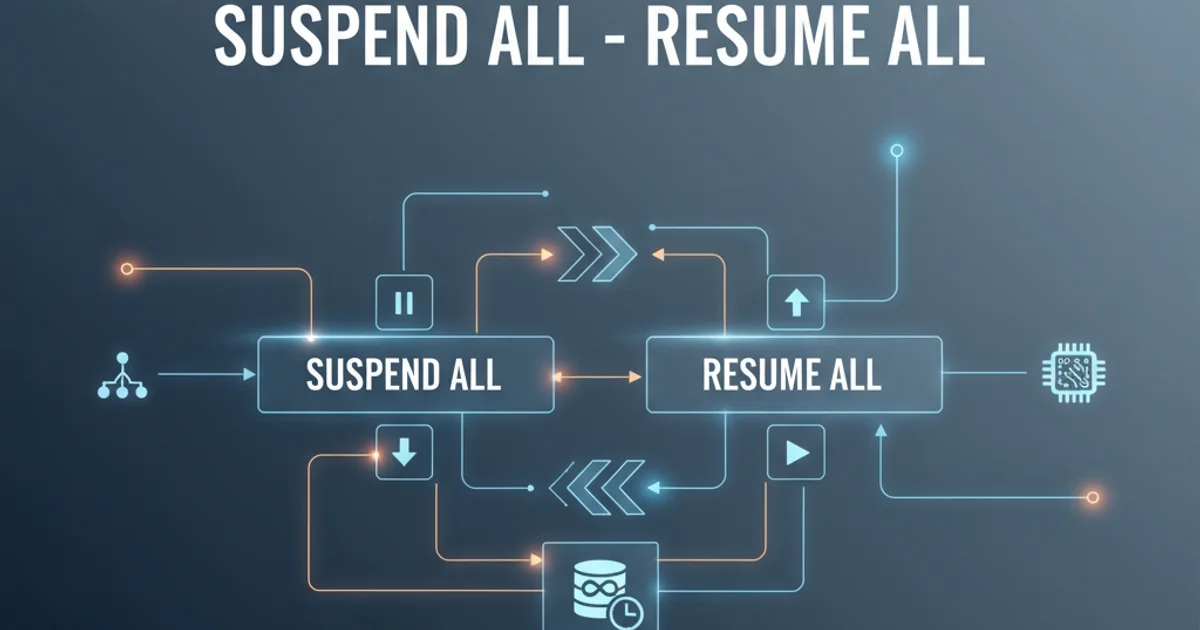Scorm 2004 4th edition Suspend All - Resume All
Categories:
Mastering SCORM 2004 4th Edition: Suspend All and Resume All

Dive deep into the SCORM 2004 4th Edition's Suspend All and Resume All mechanisms, understanding their critical role in preserving learner progress and ensuring seamless course navigation.
SCORM (Sharable Content Object Reference Model) is a set of technical standards for e-learning software products. Specifically, SCORM 2004 4th Edition introduced significant enhancements for tracking learner progress and managing course state. Among these, the 'Suspend All' and 'Resume All' functionalities are crucial for providing a robust and user-friendly learning experience, allowing learners to pause and return to their exact point in a course across multiple SCOs (Sharable Content Objects).
Understanding Suspend All
The Suspend All mechanism in SCORM 2004 4th Edition is invoked when a learner exits a course, but the LMS (Learning Management System) is expected to allow them to return to their previous state. This is distinct from a 'terminate' action, which implies a final exit. When Suspend All is triggered, the LMS is responsible for persisting the state of all active SCOs within the course. This includes not only the current SCO's data (like cmi.core.lesson_location, cmi.suspend_data, etc.) but also the overall course navigation and sequencing state. The primary goal is to ensure that when the learner resumes, they are placed back into the course exactly where they left off, with all relevant data restored.
sequenceDiagram
participant Learner
participant SCO
participant LMS
Learner->>SCO: Exit Course (Suspend)
SCO->>LMS: `LMSCommit()`
SCO->>LMS: `LMSSetValue("cmi.exit", "suspend")`
SCO->>LMS: `LMSFinish()`
LMS->>LMS: Persist all SCO states and course navigation data
LMS-->>Learner: Course suspended successfullySequence diagram illustrating the 'Suspend All' process in SCORM 2004 4th Edition.
Understanding Resume All
Conversely, Resume All is the process by which the LMS restores the learner's state when they re-enter a suspended course. This involves retrieving all the previously saved data for each SCO and the course's overall navigation state. The LMS uses this information to determine which SCO the learner should be launched into and what its internal state should be. For example, if a learner was halfway through a quiz in a specific SCO, Resume All should ensure they return to that exact quiz question with their previous answers preserved. This seamless transition is fundamental to a positive learner experience and is a key differentiator of SCORM 2004's advanced sequencing and navigation capabilities.
flowchart TD
A[Learner Launches Suspended Course]
B{LMS Detects Suspended State}
C[LMS Retrieves Stored Course Data]
D[LMS Determines Last Active SCO]
E[LMS Launches Last Active SCO]
F[SCO Initializes with Stored Data]
G[Learner Continues from Last Point]
A --> B
B -- Yes --> C
C --> D
D --> E
E --> F
F --> GFlowchart depicting the 'Resume All' process for a suspended SCORM 2004 course.
cmi.exit values (e.g., suspend, logout, normal) is crucial for the LMS to correctly interpret the learner's intent and manage data persistence accordingly.Implementation Considerations for Developers
For content developers, ensuring your SCOs correctly interact with the SCORM API for suspend/resume is vital. This includes:
- Saving
cmi.suspend_data: This data element is a free-form string where SCOs can store any internal state information needed for resumption. It's often used to save quiz progress, page numbers, or custom variables. - Setting
cmi.exit: Before callingLMSFinish(), the SCO must setcmi.exittosuspendif the learner is expected to return. Ifcmi.exitis not set or set tonormal, the LMS might not persist the necessary data for a full resume. - Handling
cmi.entry: Upon launch, the SCO should checkcmi.entry. If it'sresume, the SCO should retrieve and apply the data fromcmi.suspend_datato restore its internal state. - LMS Responsibilities: The LMS must correctly handle the
suspendexit status, persist the entire course state (including sequencing and navigation), and restore it upon re-entry. Testing this thoroughly across different LMS platforms is highly recommended.
// Example of Suspend logic within a SCO
function doSuspend() {
// Save internal state to cmi.suspend_data
var suspendData = JSON.stringify({ currentPage: 5, quizProgress: { q1: 'A', q2: 'B' } });
LMSSetValue("cmi.suspend_data", suspendData);
// Indicate exit as suspend
LMSSetValue("cmi.exit", "suspend");
// Commit changes and finish
LMSCommit();
LMSFinish();
}
// Example of Resume logic within a SCO
function doResume() {
var entry = LMSGetValue("cmi.entry");
if (entry === "resume") {
var suspendData = LMSGetValue("cmi.suspend_data");
if (suspendData) {
var savedState = JSON.parse(suspendData);
// Restore internal state based on savedState
console.log("Resuming at page: " + savedState.currentPage);
console.log("Quiz progress: " + JSON.stringify(savedState.quizProgress));
// ... apply savedState to update UI/logic
}
}
}
cmi.suspend_data is 64,000 characters. Exceeding this limit can lead to data truncation or errors, preventing proper course resumption. Plan your data storage carefully.